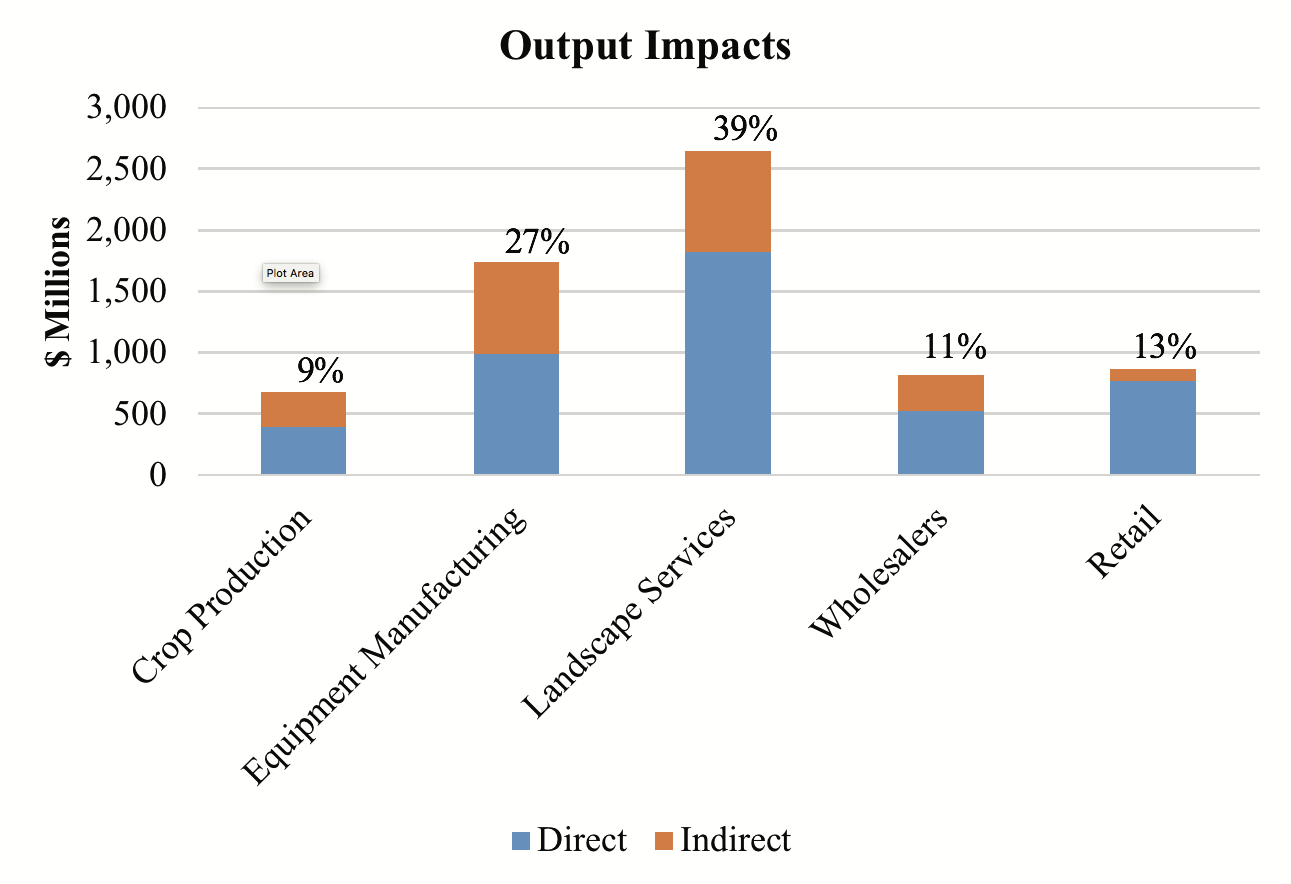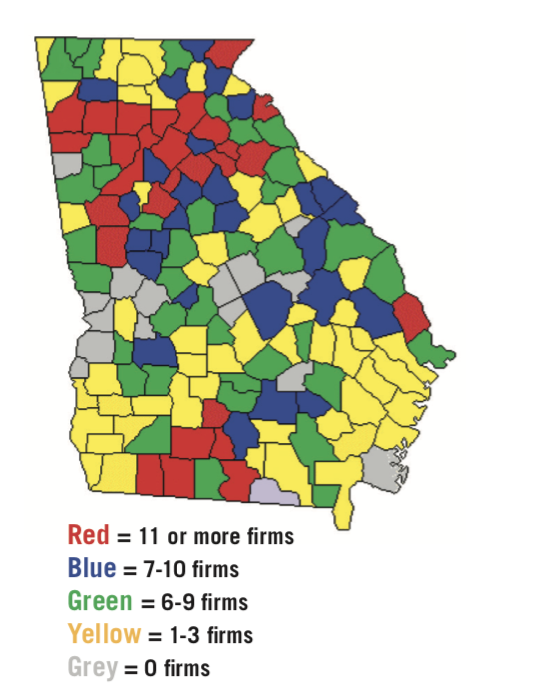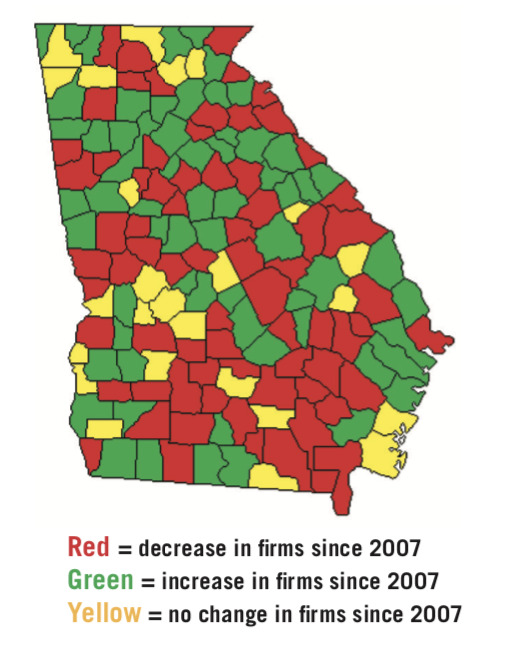Georgia green industry statistics, 2013
- Ninth-ranked state in green industry economic impact
- $6.7 billion in total regional impact
- $4.5 billion in direct output
- $2.2 billion in indirect and induced output
- 47,555 in direct employment
- 64,066 in total employment
- Fifth-largest agricultural farm gate value (including only container nursery, field nursery, greenhouse, and turf in the state of Georgia at $554 million, trialing only broilers, cotton, eggs, and beef


Georgia’s green industry consists of wholesale nurseries; greenhouses; turfgrass sod producers; landscape designers; construction/maintenance firms; and retail distribution firms, like garden centers, home stores, mass merchandisers with lawn/garden departments, brokers/rewholesale distribution centers, and allied trade suppliers (Hodges et al., 2015).
Over the past 30+ years, the Green Industry Research Consortium has conducted research on a wide variety of topics within the industry. The consortium is a multistate assembly of agricultural economists and horticulturists that join under the auspices of the U.S. Department of Agriculture (USDA) multistate group (currently S1065). Notably, for this report, the consortium develops economic impact estimates every five years for each state in the U.S. to better understand the trends and impacts of the industry. Using data from this group, published by Hodges et al. (2015), and other resources as noted throughout the rest of the circular, this report strives to understand the current (2013) state of the Georgia green industry as well as recent changes in light of the 2007-2009 recession.
Overall state of the green industry in the U.S.
The total economic impact of the U.S. green industry in 2013 was estimated at $196.07 billion with over 2 million jobs either directly or indirectly related to the industry (Hodges et al., 2015). From 2001-2013, the U.S. green industry experienced small declines in employment overall, but there were large variations among the industry sectors. The greatest increases were in the landscaping services sector (+24.6%) while the sharpest employment declines were for florists (-49.3%) followed by landscape architectural services (-28.2%), lawn and garden equipment manufacturing (-20.8%), and nursery and floriculture production (-9.0%) (U.S. Department of Labor, 2015). The general pattern for the industry in the U.S. for this period was one of rising employment up to 2007, steep decline during the 2007-09 recession, and a gradual recovery up to 2013, but the industry failed to reach its prerecession peak (Hodges, 2015).
Overall state of the Georgia green industry
The state of Georgia ranked ninth out of all states in 2013 for green industry economic contributions (including multiplier effects) to employment (64,066 jobs) and GDP ($3.79 billion) and ninth in total industry output ($6.72 billion) (Hodges et al., 2015). The industry employed 6.4 people per 1,000 persons and contributed $379 per person in GDP. The largest individual sector in regard to output and employment, both directly and indirectly, was landscape services (Figures 1 and 2), representing nearly 57% of industry employment and 39% of economic output. The Georgia green industry represented 0.83% of Georgia GDP, higher than that of the U.S. green industry as a whole at 0.72% of U.S. GDP. As pointed out in Hodges (2015), the U.S. green industry experienced fast growth in the 1980s and 1990s but slowed in the 2000s, and the industry continues to suffer lingering effects from the recession of the past decade. In comparison to the previous study of 2007 by the same authors, U.S. green industry direct output increased by 6%, while the total economic contributions increased in 2013 by 4% for employment, 2% for output, and 2.7% for GDP in inflation-adjusted terms (Hodges, Hall, and Palma, 2011; Hodges et al., 2015). In Georgia, however, the overall green industry contributions from 2007 to 2013 decreased by 3% for employment, 11% for direct industry output, and nearly 17% for GDP. These declines were even greater than those experienced in the Southeast region, which were -2.6%, -6.3%, and -11.9%, respectively (Hodges, Hall, and Palma, 2011; Hodges et al., 2015).


According to the USDA – National Agricultural Statistics Service (2014), the Georgia green industry is made up of 955 nursery, greenhouse, floriculture, and sod firms. The Georgia green industry (including sod production) had $554 million in farm gate value in 2013, making the green industry the fifth-largest agricultural commodity sector in the state (Wolfe and Stubbs, 2014). Adjusting the 2007 sales for inflation ($861 million in 2012 dollars) implies that the Georgia green industry shrank by a third from 2007 to 2012 (Boatright and McKissick, 2008; Wolfe and Stubbs, 2014). This indicates that the industry was deeply affected by the recession with the impacts varying between green industry sectors. Campbell et al. (2017) showed that the Georgia green industry in 2013 was only 66% of its 2007 value. Notably, the greenhouse sector was 90% of its 2007 farm gate value in 2013 while field nursery, container nursery, and turfgrass were 77%, 79%, and 44% of their 2007 values, respectively.
Examining firm numbers for nursery, greenhouse, floriculture, and sod producers at the county level (Figure 3) shows that the highest concentration of firms were located in high population areas in 2012. Notably, the largest concentration of red counties (11 or more firms) was located around the Atlanta, Georgia, area. Other areas with a large number of green industry firms included the areas near Tallahassee, Florida, Savannah, Georgia, and Augusta, Georgia. Counties near these areas tended to be less impacted by the recession than firms in counties with smaller populations (Figure 4).
References:
Boatright, S.R., & McKissick, J.C. (2008). 2007 Georgia Farm Gate Value Report. Center for Agribusiness and Economic Development, University of Georgia. AR-08-01. Retrieved from http://caes2.caes.uga.edu/center/ caed/pubs/2008/documents/AR-08-01.pdf
Campbell, B.L., Brewer, B., Wolfe, K., & Kane, S.P. (2017). Impact of the Recession and Drought of the Mid- 2000’s on the Environmental Horticulture Industry. Department of Agricultural and Applied Economics, University of Georgia Cooperative Extension Circular 1119. Retrieved from http://extension.uga.edu/ publications/detail.html?number= C1119
Hodges, A.W., Hall, C.R., & Palma, M.A. (2011). Economic Contributions of the Green Industry in the United States in 2007-2008. HortTechnology 21(5):628-638.
Hodges, A.W., Hall, C.R., Palma, M.A., & Khachatryan, H. (2015). Economic Contributions of the Green Industry in the United States in 2013. HortTechnology 25(6):805-814.
U.S. Department of Agriculture – National Agricultural Statistics Service (2014). Market Value of Agricultural Products Sold including Direct Sales: 2012-2007. Retrieved from https://www.agcensus.usda.gov/ Publications/2012/Full_Report/Volume_1,_Chapter_2_County _Level/Georgia/st13_2_002_002.pdf
U.S. Department of Labor (2015). Quarterly Census of Employment and Wages, Data for
All Employees and All Establishment Sizes in Selected Industries. Retrieved from http://www.bls.gov/cewWolfe, K., & Stubbs, K. (2014). 2013 Georgia Farm Gate Value Report. Center for Agribusiness and Economic Development, University of Georgia. AR-14-01. Retrieved from http://caes2.caes.uga.edu/center/ caed/pubs/documents/GeorgiaFGVR2013_FINAL.pdf
Status and Revision History
Published on Jul 18, 2018
Published with Full Review on Jun 10, 2022


























































